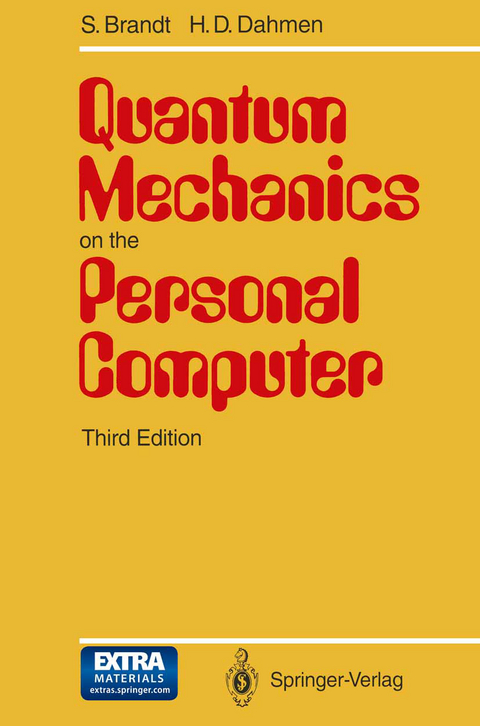
Quantum Mechanics on the Personal Computer
Springer Berlin (Verlag)
978-3-642-78657-0 (ISBN)
Dr. Siegmund Brandt ist Professor für Physik an der Universität Siegen. Er arbeitet mit seiner Siegener Gruppe bei DESY und CERN an Experimenten zur Elementarteilchenphysik.
1. Introduction.- 1.1 Interquanta.- 1.2 The Structure of this Book.- 1.3 The Demonstrations.- 1.4 The Computer Laboratory.- 1.5 Literature.- 2. Free Particle Motion in One Dimension.- 2.1 Physical Concepts.- 2.2 A First Session with the Computer.- 2.3 The Time Development of a Gaussian Wave Packet.- 2.4 The Spectral Function of a Gaussian Wave Packet.- 2.5 The Wave Packet as a Sum of Harmonic Waves.- 2.6 Exercises.- 3. Bound States in One Dimension.- 3.1 Physical Concepts.- 3.2 Eigenstates in the Infinitely Deep Square-Well Potential and in the Harmonic-Oscillator Potential.- 3.3 Eigenstates in the Step Potential.- 3.4 Harmonic Particle Motion.- 3.5 Particle Motion in the Infinitely Deep Square-Well Potential.- 3.6 Exercises.- 4. Scattering in One Dimension.- 4.1 Physical Concepts.- 4.2 Stationary Scattering States in the Step Potential.- 4.3 Scattering of a Harmonic Wave by the Step Potential.- 4.4 Scattering of a Wave Packet by the Step Potential.- 4.5 Transmission and Reflection. The Argand Diagram.- 4.6 Exercises.- 4.7 Analogies in Optics.- 4.8 Reflection and Refraction of Stationary Electromagnetic Waves.- 4.9 Reflection and Refraction of a Harmonic Light Wave.- 4.10 Scattering of a Wave Packet of Light.- 4.11 Transmission, Reflection and Argand Diagram for a Light Wave.- 4.12 Exercises.- 5. A Two-Particle System: Coupled Harmonic Oscillators.- 5.1 Physical Concepts.- 5.2 Stationary States.- 5.3 Time Dependence of Global Quantities.- 5.4 Joint Probability Densities.- 5.5 Marginal Distributions.- 5.6 Exercises.- 6. Free Particle Motion in Three Dimensions.- 6.1 Physical Concepts.- 6.2 The 3D Harmonic Plane Wave.- 6.3 The Plane Wave Decomposed into Spherical Waves.- 6.4 The 3D Gaussian Wave Packet.- 6.5 The Probability Ellipsoid.- 6.6 Angular-Momentum Decomposition of a Wave Packet.- 6.7 Exercises.- 7. Bound States in Three Dimensions.- 7.1 Physical Concepts.- 7.2 Radial Wave Functions in Simple Potentials.- 7.3 Radial Wave Functions in the Step Potential.- 7.4 Probability Densities.- 7.5 Harmonic Particle Motion.- 7.6 Exercises.- 8. Scattering in Three Dimensions.- 8.1 Physical Concepts.- 8.2 Radial Wave functions.- 8.3 Stationary Wave Functions and Scattered Waves.- 8.4 Differential Cross Sections.- 8.5 Scattering Amplitude. Phase Shift. Partial and Total Cross Sections.- 8.6 Exercises.- 9. Special Functions of Mathematical Physics.- 9.1 Basic Formulae.- 9.2 Hermite Polynomials.- 9.3 Eigenfunctions of the One-Dimensional Harmonic Oscillator.- 9.4 Legendre Polynomials and Associated Legendre functions.- 9.5 Spherical Harmonics.- 9.6 Bessel functions.- 9.7 Spherical Bessel functions.- 9.8 Laguerre Polynomials.- 9.9 Radial Eigenfunctions of the Harmonic Oscillator.- 9.10 Radial Eigenfunctions of the Hydrogen Atom.- 9.11 Simple Functions of a Complex Variable.- 9.12 Exercises.- 10. Additional Material and Hints for the Solution of Exercises.- 10.1 Units and Orders of Magnitude.- 10.2 Argand Diagrams and Unitarity for One-Dimensional Problems.- 10.3 Hints and Answers to the Exercises.- Appendix A. A Systematic Guide to IQ.- A.1 Dialog Between the User and IQ.- A.1.1 A Simple Example.- A.1.2 The General Form of Commands.- A.1.3 The Descriptor File.- A.1.4 The Descriptor (Record).- A.1.5 The PLOT Command.- A.1.6 The STOP Command.- A.1.7 HELP: The Commands HE and PH.- A.2 Coordinate Systems and Transformations.- A.2.1 The Different Coordinate Systems.- A.2.2 Defining the Transformations.- A.3 The Different Types of Plot.- A.3.1 Choosing a Plot Type: The Command CH.- A.3.2 Cartesian 3D Plots (Type 0 Plots).- A.3.3 Polar 3D Plots (Type 1 Plots).- A.3.4 2D Plots (Type 2 Plots).- A.3.5 3D Column Plots (Type 3 Plots).- A.3.6 Special 3D Plots (Type 10 Plots).- A.4 The Background in the Plots.- A.4.1 Boxes and Coordinate Axes: The Command BO.- A.4.2 Scales.- A.4.3 Arrows.- A.4.4 Text and Numbers.- A.4.5 Mathematical Symbols and Formulae.- A.5 Further Commands.- A.5.1 Line Styles.- A.5.2 Multiple Plots.- A.5.3 Combined Plots.- A.5.4 Using Different Plotting Devices.- A.5.5 The Different Running Modes.- A.5.6 Definition of Physical Variables: The Commands V0 to V9.- A.5.7 Reserved Commands.- Appendix B. How to Install IQ.- B.1 Hardware Requirements.- B.2 Operating-System Requirements.- B.3 Diskette Format.- B.4 Installation.- B.5 Reformatting IQ for Different Types of Diskette.- Appendix C. Lists of All Files Provided.- C.1 Command Files.- C.2 Program Files.- C.3 Descriptor Files for Examples and Exercises.- C.4 Command Input Files and Associated Descriptor Files for Demonstrations.- C.5 DataFiles.- C.6 HelpFiles.- Appendix D. Graphics Devices and Metafiles.- Index of IQ Commands.
| Erscheint lt. Verlag | 13.4.2014 |
|---|---|
| Zusatzinfo | XIII, 314 p. 3 illus. |
| Verlagsort | Berlin |
| Sprache | englisch |
| Maße | 155 x 235 mm |
| Gewicht | 510 g |
| Themenwelt | Naturwissenschaften ► Chemie ► Physikalische Chemie |
| Naturwissenschaften ► Physik / Astronomie ► Quantenphysik | |
| Naturwissenschaften ► Physik / Astronomie ► Theoretische Physik | |
| Schlagworte | Computational Physics • Lehrsoftware • Quantenmechanik • quantum mechanics • Simulaltionsprogramm • Simulation Program • teaching software • theoretical physics • Theoretische Physik |
| ISBN-10 | 3-642-78657-X / 364278657X |
| ISBN-13 | 978-3-642-78657-0 / 9783642786570 |
| Zustand | Neuware |
| Haben Sie eine Frage zum Produkt? |
aus dem Bereich


